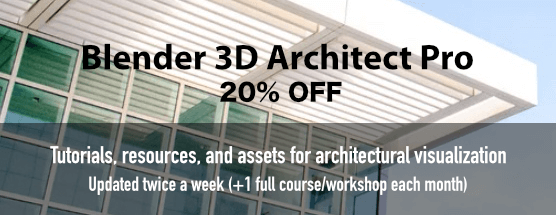Modeling for architecture with Python scripts: Collecting ideas
In just a few days I will start a new research project involving the development of a few tools and scripts for Blender, aimed in architectural modeling. I know that some of those tools may already exist, but the focus of the project is to find the best way to manage procedural modeling in Blender. Since Blender is a general modeling tool it lacks tools to enhance the workflow of architectural modeling. For instance, there is no dedicated tool to create stairs or doors.
The objective of the project is to create those tools and help architectural visualization artists. I already have a few ideas, like a tool to create stairs and doors.

If you could point out an object or architectural element that is hard to model in Blender, and would work better as a parametric modeling tool, which object is that?
As a way to start the project I was thinking about curtain walls or maybe stairs. By the time those tools are working, I will of course release them as a free download here, and distribute them to help architectural visualization artists.
I`m open to suggestions on what objects to focus first.




Comments
Tella
Great idea!
Roofs are always hard.
A catalog of easy to setup moldings (by line).
I haven’t seen any curtain procedurals, but it would be awesome, as they are quite time consuming.
Cheers!
Allan Brito
Thanks.
Roofs will be a lot of fun to work with! 🙂
maces
Hi,
AFAIK there is a script for stairs, and it works well(249b).
I already have an idea for something like an array modifier in two dimensions at once and with a random factor for loc/rot/scale. It could use given objects (UV-mapped ect.) and place them with fixed count (array) or to fill a given area (maybe with holes in that area). You could use this for several parts of old buildings, like an exterior paver floor with broken and rotated paver or for roofs, ect.
Well I never had written a Script for blender, but I know a bit of Python and I’m willing to learn how to do this.
It would be very cool if you could open a Forum (discussion, testing beta-tutorials) and a Wiki (working tutorials ect)(I could help settings this up, if you like) or get space at blender.org/. For first tests an irc channel and a static page on your blog would be enough, I think.
I think this is a very cool Project and I’m glad to help, if possible.
maces
maces
Hi,
there is a stairs script for 249b, AFAIK.
It would be cool if you could setup a forum and a wiki for discussion and documentation (I could help you with this, if you like). For first tests and IRC channel and a static page on you blog would be enough, I think.
My first idea:
– Advanced array:
– use several objects for the array (each with UV-mpa ect. by user)
– two dimensions at once (so you don’t have to set everything twice)
– random for loc/rot/scale
– beside fixed count and “fill area” option
– will fill a given area and bear in mind of holes in that area
=> would be perfect for old, broken paver and roofs
– You can fill places and Roofs very fast
– You can (with curve modifier) setup a paver/…-path in exteriors
– if it is performable you could try it with grass 😛
maces
maces
Woops sorry I forgot that you setup your blog to review the posts before there are showing, could you please use the second post? the one which contains parts of the third (which isn’t needed then)
maces
differentsmoke
Allan,
(firefox blinked and a rather extensive post suddenly wasn’t there anymore… the most annoying thing I’ve experienced yet… here I go again)
To me the least architectural feature of Blender has always been the lack of a good drafting interface.
Honestly, while premade “parametric”(a word that hides more than it communicates, nowadays) solutions are very useful from massive comercial point of view, as a purely disciplinary concern I think they hinder design more than they enrich it.
If you’ll go into parametrization, then I’d rather have abstract work benches rather than concrete solutions: maybe a complexification of the Array modifier, or a more straightfoward use of things like curvePaths+dupilframes, which allow from some interesting “Arrays”.
Still, my main issue with blender for architecture is to have an easier way to go from dragins to 3d models and back to drawings again. I think the capabilities are all there(specially with the advent of BMesh), but they have to be articulated as a coherent workflow(and AFAIK, that’s one of python’s main roles in the new blender).
Those are my thoughts: I apologize if they are not useful to your original purpose.
One more thing, as a colleague interested in Blender, scripting and OSS in general, I’d be very interested in participating, if I can. Unfortunately, my BPython skills are currently almost non-existant(I’m teaching myself python again, and I’m trying to make sense of the API), but I do have experience with coding(RhinoScript, Processing, Action/JavaScript) and I did manage to program Conway’s Game of Life once in Blender 2.4X.
cheers,
Pablo.
Chris Landau
This is great news. More Complex Arrays have my vote. The ability to randomize instance properties based on sliders, etc would be excellent. Is there a way to add an Attractor modifier to the array tool? (Like this: http://api.ning.com/files/SvYus8Zcpw5MdVd-PJCp7O30fCey1UJ729Pu4BId-C*D7W8ut8LiX7ndREJjOe9K/PolylineAttractorRender1.png )
rbtyod
Allan,
Traditional double hung windows provide endless variations that could be parametrized in a generation script.
…Bob
P.S.
I love your website.
Trumpetto
Great idea!
My problem is maybe the same. There are a lot of pieces but I miss the bundling of them all. I ‘write’ my houses in OpenSCAD (openscad.org/) and as I’m a programmer that is the perfect thing for me. On the way I wrote a lot of functions for different elements.
A bundling of tools for door, window, roof, wall, staircase and floors in Blender would make me think again.
Benjamin Bailey (Banor)
Awesome, man! Alright, here’s my suggestion: a fence. Not a simple white-washed fence, but a chain-link fence. This script could also have an option to not include the post or gate, but just the mesh-like fence, which could be useful for things like office pencil holders or a wire grate.
Yorik
I recently came across this:
http://parama.sourceforge.net/
Seems pretty interesting, but I didn’t have enough time to dig further. And the project is quite old already and not maintained anymore. Also, take a look at something called structuresynth… Not python or blender, but good ideas to grab.
I have that project to try to integrate something like that in freecad too one of these days…
Luis
I’d suggest the possibility of an snapping tool easier to use and closer to that used in cad sistems (autocad).
In the second hand, the possibility of copying several objects at the same time, via the array modificator or not would be very useful in my opinion.
ERasnier
Don’t know if it’s achievable but it would be awesome to have a 3D to 2D export kind of thing for blueprints with dimensions scale, author/drawing details etc. Both for Architecture and objects.
eks
Hai, A rectangle curve(not mesh). An architectural modeler need it always. Now we have to make a circle and convert it to a rectangle or make by shape tool in normal way. I think it is important. If anybody can make an add-on script or something like that it will be very helpfull.
thank you
Rémi
Maybe it could be of some help, here are a lot of ruby scripts for sketchup : http://www.crai.archi.fr/RubyLibraryDepot
Ok it’s not coded in python and it’s not intented for blender but the algorithm should be pretty much the same…
Garu
i also vote for roofs! and curtains? they’re really time consuming to model..
Alain
As you already know, there are alot of CAD-Tools Projects in the pipe already (ProCAD, CAD-Tools (from Migius)) and there has been an extra roundtable at the blender conference (I can’t remember which year it was, I guess 2008).
But they all lack in the ease of use.
Beside al the things that have been mention already there are the following points I would add/ think about:
-Generel: Connect your ideas together an do not split your CAD-Project-groups all over the world
-Railings
-Some functions like Scatter for 3d max
-A script like the “Floor Generator” for 3d max http://www.cg-source.com/floorgenerator.php
-Unique material ID like here: http://www.cg-source.com/uniquematerialids.php
-A “Cut by plane” Modifier
Kind regards
Alain
George
Something like paneling tools for rhino would be nice, maybe using more advance arrays over surfaces!
To be able to accurately parallel offset edges of complex shapes would be a dream.
And a hidden line render would be great like in sketch up! to render out drawings it would be great ( i don”t mean wireframe, I mean the object edges (simplified Subsurf edges) that are on the visible faces.)
Some sort of pipe tool would be great. Like the pipe tool in rhino or the follow me tool in sketch up. To be able to draw a section profile and the extrude it along a curve or even an edge would be good.
stanmarsh
hi allan,
this is a great initiative!
i like to see in blender a way to draft 2d objects like lines and curves easily. the idea is similar to “surface sketching” but with greater 12control for archviz.
Surface Sketching by Blend_Ideas
http://vimeo.com/10695820
cheers
Tom
From the point of view of green architecture and analysis (see your former post dated April 6), it would be very nice to have these kind of tools available in Blender.
From commercial point of view it would then be nice to have a tool that creates 3d models out of 2d drawings. Next to this it would be very helpful to have some kind of “standard objects/materials” like a wall with customizable thickness, air gap, isolation,… (features available in Autodesk Revit for example).
It seems to me you’d have a powerful tool for optimizing design and you get stunning 3d vizualizations almost for free.
I also apologize if this posting was not that useful for the original purpose of this thread because of the focus on a tool to (automatically) create 3d objects from 2d drawings. It seems to me that such a tool would be very useful, but currently not available.
Kind regards
Jerry
Hello!
Parametric tools are great when the amount of parameters to enter is minimal, or appear only when the context is relevant, or when one asks for more.
Perhaps a tool for drawing a road and projecting or placing it on a terrain model might be useful?
However on top of my wish list is a tool for rendering any type of projection (ortho, central, curvilinear, 360 …), into useful 2D vector graphics files. Perhaps Freestyle (or Pantograph?) will be able to do this?
maces
Well I think for organizing an improved outliner would be good, I have some ideas in mind, including a “database” (blendfiles) with materials, objects, animations and so on in them.
I would suggest to let us some time to get creative and think off tools and let us inspire. Then we should meet on irc/whereever and discuss them, make project groups. While doing this we should use a wikipage(blender.org?)/images ect. to dokument and clarify what we’re meaning 😉
maces
Allan Brito
Thanks to everyone for your suggestions. They will really help me to start of the project.
Soon I will create a wiki or forum to post the progression on the development. And for those willing to help, any contribution will be welcome!
Allan Brito
I just found a great reference.There is a script for SketchUp called 1001bits. My idea would be to create something like it for Blender. They have lots of parametric modeling tools:
http://www.1001bit.com/
nf3
great idea. my 2cts:
a) for me, a holy grail would be the already mentioned proposal of a sort of ‘duplimaterials’, ie, a way to set duplicated objects with variations in the material, to easily develop tiles, bricks and the like
b) the ‘improved array’ also is a choice. maybe like a configurable grid to place objects at will, also with configurable independent rotations. Dupliobjects is cumbersome to set up and rotations depend on non editable vertex normals.
c) another choice I considered, but out of my capabilities: a script of scripts, wich blends in one single front end some useful for architecture editing scripts: Big numbers toolkit, RobertT aligner, geom tools, Loop tools…
d) there was also the discontinued Kloputils script, wich contained many useful ideas. It’s unstable now, it would be good someone updated it.
Mark
AFAIK none of the existing stairs scripts create nice railings. One that does would be nice to have but somewhat challenging to make.
Nick
I made a script to create stairs with railings in Blender 2.49. Here it is:
#! /usr/bin/env python
”’
Title: Stairs and railing creator script for blender 2.49
Author: Nick Trefiak
Date: 2010 08 09
Description:
Creates a straight-run staircase with railings and stringer
All components are optional and can be turned on and off by setting e.g. makeTreads=True or makeTreads=False
No GUI for the script, all parameters must be defined below
Current values assume 1 blender unit = 1 metre
Stringer will rest on lower landing and hang from upper landing
Railings start on the lowest step and end on the upper landing
NOTE: You must have numpy installed for this script to work!
numpy is used to easily perform the necessary algebra
numpy can be found at http://www.scipy.org/Download
Note: I’m not sure how to use recalcNormals so not all normals points ouwards.
Perhaps someone else can contribute this.
”’
#———————————————————————
”’define all parameters here”’
global rise, run
rise=0.20 #single tread rise, including the tread height
run=0.30 #single tread run, not including the nosing
#for treads
makeTreads=True
wT=1.2 #tread width
hT=0.04 #tread height
tT=0.03 #tread toe, a.k.a. nosing
nT=10 #number of treads
#for posts
makePosts=True
dP=0.04 #post depth
wP=0.04 #post width
nP=5 #number of posts
#for railings
makeRailings=True
wR=0.12 #rail width
tR=0.03 #rail thickness
hR=0.90 #rail height
#for retainers
makeRetainers=True
wRR=0.01 #retainer width
hRR=0.01 #retainer height
nRR=3 #number of retainers
#for stringer
makeStringer=True
wS=0.15 #stringer width, set equal to tread width for fully enclosed riser
#———————————————————————
”’import modules”’
from Blender import *
import bpy
import math
from numpy import *
#———————————————————————
”’classes for mesh creation”’
class General:
”’common data, methods needed for other objects”’
def __init__(self,rise,run,N):
self.start=zeros((3))
self.stop=float(N)*array([run,0,rise])
self.slope=rise/run
self.angle=arctan(self.slope)
#identical quads for all objects except stringer
self.faces=[[0,1,3,2],[0,1,5,4],[0,2,6,4],[4,5,7,6],[2,3,7,6],[1,3,7,5]]
def Make_mesh(self,coords,faces,meshname,objname):
”’make a mesh given the vertex coordinates, faces, and names for mesh and object”’
me = bpy.data.meshes.new(meshname)
me.verts.extend(coords.tolist())
me.faces.extend(faces)
scn = bpy.data.scenes.active
ob = scn.objects.new(me, objname)
class Treads:
”’class for creating treads”’
def __init__(self,w,h,d,r,toe,N):
self.w=w #tread width
self.h=h #tread height
self.d=d #tread run
self.r=r #tread rise
self.t=toe #tread nosing
self.N=N #number of treads
self.Create()
def Create(self):
for i in range(self.N):
coords=zeros((8,3))
coords[0,:]=[-self.t,0,0]
coords[1,:]=[self.d,0,0]
coords[2,:]=[-self.t,self.w,0]
coords[3,:]=[self.d,self.w,0]
coords[4:,:]=coords[0:4,:]+array([0,0,-self.h])
coords=coords+array([i*self.d,0,i*self.r])
G.Make_mesh(coords,G.faces,’tMesh’,’tObj’)
class Posts:
”’class to create posts”’
def __init__(self,d,w,wT,nP,hR,tR):
self.x1=G.start+array([0,0,hR-tR]) #rail start
self.x2=G.stop+array([0,0,hR-tR]) #rail stop
self.d=d #post depth
self.w=w #post width
self.wT=wT #tread width
self.nP=nP #number of posts
self.sp=array([(self.x2[0]-self.x1[0])/float(nP+1),0,0]) #spacing between posts
self.Create()
def Intersect(self,i,d):
”’find intersection point, x, for rail and post”’
x3=self.x1+i*self.sp+d
x4=x3+array([0,0,self.x2[-1]])
a=self.x2-self.x1
b=x4-x3
c=x3-self.x1
cr_ab=cross(a,b)
mag_cr_ab=(cr_ab**2).sum()
return self.x1+a*(dot(cross(c,b),cr_ab)/mag_cr_ab)
def Create(self):
for i in range(0,self.nP+2,1):
coords=zeros((8,3))
#intersections with rail
coords[0]=self.Intersect(i,0.0)
coords[1]=self.Intersect(i,self.d)
#intersections with tread
coords[2]=array([self.x1[0]+i*self.sp[0],0,int(coords[0,0]/run)*rise])
coords[3]=coords[2]+array([self.d,0,0])
#inner face
coords[4:,:]=coords[0:4,:]+array([0,self.w,0])
G.Make_mesh(coords,G.faces,’pMesh’,’pObj’)
#make post on other side of steps as well
coords=coords+array([0,self.wT-self.w,0])
G.Make_mesh(coords,G.faces,’pMesh’,’pObj’)
class Rails:
”’class for creating railings”’
def __init__(self,w,t,h,tT,wP,dP,wT):
self.w=w #rail width
self.t=t #rail thickness
self.h=h #rail height
self.start=G.start+array([0,0,self.h-self.t]) #rail start
self.stop=G.stop+array([0,0,self.h-self.t]) #rail stop
self.tT=tT #tread toe
self.wP=wP #post width
self.dP=dP #post depth
self.wT=wT #tread width
self.Create()
def Create(self):
#determine offset to include railing toe
offset=array([self.tT,0,self.tT*tan(G.angle)])
coords=zeros((8,3))
coords[0]=self.start-offset
coords[1]=self.stop+offset+array([self.dP,0,self.dP*tan(G.angle)])
coords[2]=self.start-offset+array([0,self.w,0])
coords[3]=self.stop+offset+array([self.dP,self.w,self.dP*tan(G.angle)])
coords[4:,:]=coords[0:4,:]+array([0,0,self.t])
#centre over posts
coords=coords+array([0,0.5*(-self.w+self.wP),0])
G.Make_mesh(coords,G.faces,’rMesh’,’rObj’)
#make rail on other side
coords=coords+array([0,self.wT-self.wP,0])
G.Make_mesh(coords,G.faces,’rMesh’,’rObj’)
class Retainers:
”’class for creating retainers”’
def __init__(self,w,h,wP,wT,nR):
self.w=w #retainer width
self.h=h #retainer height
self.wP=wP #post width
self.wT=wT #tread width
self.nR=nR #number of retainers
self.sp=hR/float(nR+1) #retainer spacing
self.Create()
def Create(self):
for i in range(self.nR):
coords=zeros((8,3))
offset=(i+1)*array([0,0,self.sp])
coords[0]=G.start+offset
coords[1]=G.stop+offset
coords[2]=G.start+offset+array([0,self.w,0])
coords[3]=G.stop+offset+array([0,self.w,0])
coords[4:,:]=coords[0:4,:]+array([0,0,self.h])
#centre in posts
coords=coords+array([0,0.5*(self.wP-self.w),0])
G.Make_mesh(coords,G.faces,’rrMesh’,’rrObj’)
#make retainer on other side
coords=coords+array([0,self.wT-self.wP,0])
G.Make_mesh(coords,G.faces,’rrMesh’,’rrObj’)
class Stringer:
”’class for creating stringer”’
def __init__(self,w,nT,hT,wT):
self.w=w #stringer width
self.nT=nT #number of treads
self.hT=hT #tread height
self.wT=wT #tread width
self.faces=[[0,1,3,2],[1,5,3],[3,5,4],[6,7,9,8],[7,11,9],[9,11,10],[0,2,8,6],[0,1,7,6],[1,5,11,7]]
self.Create()
def Create(self):
for i in range(self.nT):
coords=zeros((12,3))
coords[0]=G.start+array([0,0,-rise])
coords[1]=G.start+array([run,0,-rise])
coords[2]=G.start+array([run*0,0,-self.hT])
coords[3]=G.start+array([run*1,0,-self.hT])
coords[4]=G.start+array([run*1,0,0])
coords[5]=G.start+array([run*2,0,0])
coords[6:]=coords[0:6]+array([0,self.w,0])
coords=coords+i*array([run,0,rise])
#centre below tread
coords=coords+array([0,0.5*(self.wT-self.w),0])
G.Make_mesh(coords,self.faces,’sMesh’,’sObj’)
#———————————————————–
”’create meshes”’
editmode = Window.EditMode() # are we in edit mode? If so …
if editmode: Window.EditMode(0) # leave edit mode before getting the mesh
global G
G=General(rise,run,nT)
if makeTreads: Treads(wT,hT,run,rise,tT,nT)
if makePosts: Posts(dP,wP,wT,nP,hR,tR)
if makeRailings: Rails(wR,tR,hR,tT,wP,dP,wT)
if makeRetainers: Retainers(wRR,hRR,wP,wT,nRR)
if makeStringer: Stringer(wS,nT,hT,wT)
if editmode: Window.EditMode(1) # optional, just being nice
Nick
Since this site strips leading spaces all the indentation in my previous post is lost. http://pastebin.com/RwnRXgZ7 has the code with indents.
indianfriend
Allan, a tool to create slopping roof by giving angle will be a great thing for architectural visualizers
archimage
Hi Allan, Very nice work !
Looking at revit’s basic toolbox could be a good starting point : wall, floor, openings, window, door
This kind of tools are very useful to work fast in architecture, especially when they are parametric.
Using parametric dimensions between vertices, edges or faces could be also a good thing.
I think more complex tools like paneling tools but for more specific projects…
Good luck !